Ulsan - metropolitan city in South Korea
Ulsan (dead link: January 2023) (울산(蔚山)) is a city in South Gyeongsang. It is the capital of the Ulsan Metropolitan District.
Understand

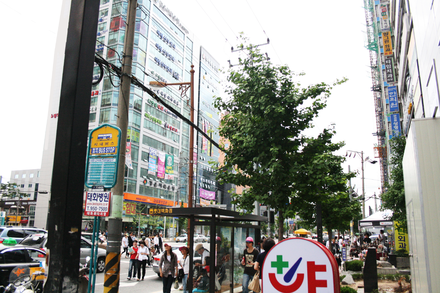
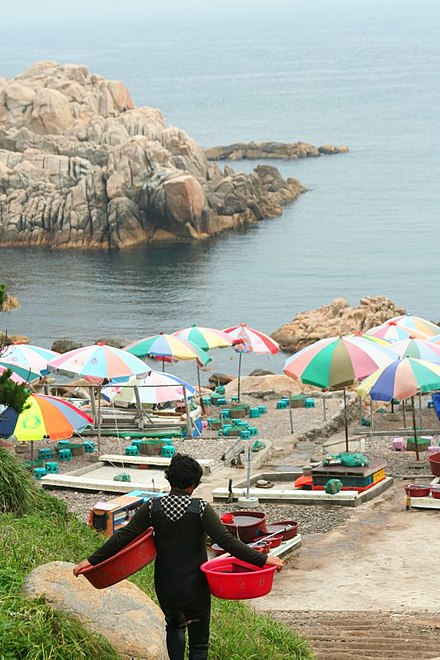
Ulsan is a seaside metropolitan city in the southeast of Korea with a population of 1.2 million. The city is known for its whaling heritage and as the industrial heart of the country.
While Ulsan is not listed in many tourist guides, it is the gateway to the Yeongnam Alps, considered to be one of the most beautiful national parks in South Korea. It also has twelve designated "Scenic Areas", from natural icons to man made buildings. Today the city lives in a Catch-22 situation; in some districts it is impossible to escape the industries. Although these industrial sites are breath-taking in scope, a testament to the achievement of man, they blight the landscape. On the other hand, the investment from these industries undeniably makes the city an better place to be. Ulsan was a World Cup 2002 host city.
Orientation
Ulsan City is 70 km north of Busan, but also close to Gyeongju, Daegu and Pohang.
Ulsan includes 4 wards ("Gu") and 1 county ("Gun"):
- Buk-gu (북구; 北區) - The most northern the four Gu and rapidly developing due to the lack of pollution in the area.
- Dong-gu (동구; 東區) - The location of Bangeojin, Hyundai and a large amount of the city's ship building industry (including the largest ship-yard in the world).
- Jung-gu (중구; 中區)
- Nam-gu (남구; 南區)
- Ulju-gun (울주군; 蔚州郡)
Samsandong, home of the Lotte and Hyundai department stores, can be considered the up-market district. Western fashion brands are available along with a number of western chain restaurants. The neon lit back streets yield a vibrant bar and restaurant culture. The Lotte Ferris wheel is also in this area next to the Lotte Cinema.
Old down-town, Seongnamdong, is good for shopping at low, local prices (there are brand goods shops too however). It is the location of a small number of foreigner friendly/foreigner run bars.
Mugeodong, the home of Ulsan University, is the best place for the young, twenty-somethings wishing to eat, drink and party.
When to visit
The best months tend to be from March through May before it gets too hot. Summer serves up a heavy sweat-inducing humidity along with prolonged rain showers mixed with the occasional typhoon. It remains warm until late October (cited by many to be the best month) at which point the weather turns cold. But it is not uncommon even in December to have warm spells with temperatures plummeting at night. Ulsan sees little snow due to its southerly position on the Korean peninsular - however that is not to say that snow can not fall. When it does fall, it can be heavy.
Get in
By plane
As Ulsan receives no international flights, it is only possible to arrive in the city via the air from two destinations - Seoul (Gimpo) and Jeju-do.
Getting to Ulsan by plane from Incheon International Airport requires a transfer upon landing to Seoul Gimpo Airport, which can be done by either train (Arex) or Limosine bus.
An easier option might be to take the KTX high speed train directly from Incheon International Airport to Ulsan (no changes required).
The flight from Gimpo (operated by Korean Air and Asiana) takes about one hour. Weekday fares start at ₩62,000 rising to ₩71,000 at weekends. (The tourist information booth on the ground floor is a must before leaving the airport for great maps of the city and many leaflets on things to do. There is also literature on Gyeongju) Those wanting to get to and from Gyeongju usually pass through Ulsan airport too. A direct bus service to Gyeongju runs 4 times a day. Departures from Ulsan Airport are at 08:20 11:40 16:10 18:40. Departures from Gyeongju Express Bus Terminal, Platform No.5 are at 07:00, 10:10, 14:30, 17:20.
Another option is to fly into Busan's Gimhae International Airport which is about an hour and a half away by bus.
If you are flying in directly to Incheon International Airport, you can also take the bus from the airport directly to Ulsan. It leaves from stand 10C outside arrivals, costs approximately ₩40,000 one way and takes about five hours.
By train
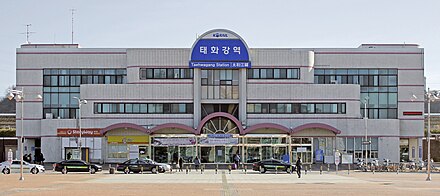 Ulsan has rail links with the rest of the country and it is possible to get to the city without too much trouble or waiting.
Ulsan has rail links with the rest of the country and it is possible to get to the city without too much trouble or waiting.
KTX
KTX serves Ulsan directly. The train station is not in the city center, but to the west of the city in Eonyang. It is for further away from downtown than even the airport, however Ulsan City is accessible by bus from the station.
The regular city buses (yellow and white) cost ₩1,150 when using cash, or ₩1,100 when using a transportation card, and are the cheapest, although not the most comfortable way or quickest to get to the city center. The 327, 337 and 807 all run to Samsan-dong, which is the downtown of Ulsan, while other routes stay outside of the city core. These buses do not use the expressway and even makes some stops that are somewhat out of the way, so they may take considerably longer than the buses below to the city center.
One Chwaseok (seated) bus line runs as well to the KTX station, route number 1703. It costs ₩1,700 by cash, or ₩1,500 using a transportation card. It uses the expressway to the city center, so it is quicker and has more comfortable seats as the regular city buses.
There are also four express buses (5000 series) which run from the station to various parts of the city. They cost ₩3,200 when paid in cash, or ₩3,000 by transportation card. These buses have the most comfortable seats and make limited amounts of stops along the way. While not very high frequency (about 2 departures per hour), they are timed to depart after the trains arrive at Ulsan station.
Standard trains
The non-high speed Ulsan station has been renamed to Taehwagang (Taehwa River) Station, while only the new KTX station is now named Ulsan station.
There are no longer any slow (Saemaul or Mugunghwa) trains that go to Seoul. Most now terminate in Dongdaegu Station and Bujeon station in Busan, with a few runs to Pohang and other places.
Taehwagang station is a brisk 20-minute walk from the center of Samsandong following the main road straight ahead after going outside. Look for the Lotte Ferris wheel. Taxis are available to the Taehwagang Station.
When travelling between Busan and Ulsan, it is worth taking the train since the sight varies from the endless industrial backdrop of Ulsan to some breathtaking views of the sea along the way to Busan. The part especially near Haeundae is very nice as the route circles around the Dalmaji hill gives an endless view of the ocean. This line is under construction for an upgrade from single track to double track, and the part around Haeundae is being completely rerouted away from the sea meaning these sea views won't last for long.
By car
Getting to Ulsan by car is simple enough using the national expressway system:
- From Seoul, Daejeon and Daegu, take the Gyeongbu Expressway towards Busan and exit at Eonyang junction.
- From Gwangju, take the Namhae Expressway towards Busan and exit at Wonyang junction.
- From Chuncheon, take the Jungang Expressway towards Daegu, then switch to the Gyeongbu Expressway towards Busan at Geumho junction.
- From Eumseong and Cheongju take the Jungbu Expressway towards Daejeon and then switch to the Gyeongbu Expressway towards Busan at Nami junction.
By bus
Ulsan is well served by intercity buses and it is possible to get to the city from any other major (and not so major) location in the country. The city terminals are located a brief walk across the street from each other in Samsandong with a smaller terminal in Bangeojin. It is also possible to jump off these buses at the major neighborhoods or intersections on the way into the city (Gongeotap and Shinbok rotaries being a notable two).
- From Seoul - It takes about 4 to 5 hours depending on traffic. The express bus runs from the Express Bus Terminal in Seocho-Gu in Seoul to Ulsan with departures about once every 30 minutes. There also is an intercity bus running from the Dong-Seoul bus terminal once every 30 to 40 minutes to the Intercity Bus Temerminal in Samsan Dong in Ulsan, as well as two departures a day from the same terminal to the Bangeojin terminal.
- From Busan There are several options for the Busan - Ulsan route. From the Nopodong bus terminal in northern Busan, you can take both the Chwasok (seated) city buses and the intercity buses that both run to Samsandong in Ulsan. For the Chwaseok buses, 1127, 1137, 2100, and 2300 all can be used (1127 runs to Mugeodong and Seongnamdong while the other buses take a more direct route to Samsandong). The cost is ₩2,000 if you use a transportation card, or ₩2,200 if you pay in cash. Alternately you can also use the Intercity bus which runs the same route, but makes less stops, so it is slightly quicker and has very comfortable seats (only three per row). Buses are very frequent (once every 7 minutes during the daytime) with the last departures at 02:00 from both sides. The cost is ₩4,000 which goes up to ₩5,900 after 22:00. There are additionally Intercity buses that run to Bangeojin as well.
- From Haeundae, there are intercity buses running from the Haeundae bus terminal, which is directly across the street from the Haeundae train station. Local service runs once every 30 minutes to the Samsandong terminal, and takes about 1½ hours. The direct service which uses the expressway runs once every 20-30 minutes and takes 1 hour. In order to buy a ticket for the direct service, you should mention "Jik-tong" (직통), which is Korean for direct since the local bus is more expensive even if you get on and off at the same exact stops!
By boat
There are no ferry services to Ulsan though some people do arrive via work on boats that make port at the shipyards. The nearest international ferry services for the general public are in Busan where they arrive from a whole host of places including China and Japan. It is very rare that anyone would want to come to Ulsan for the first time using these services. Many English teachers make use of the ferries in Busan for the E-2 visa run to Fukuoka in Japan.
Get around
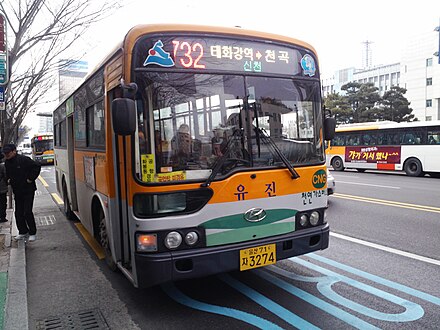
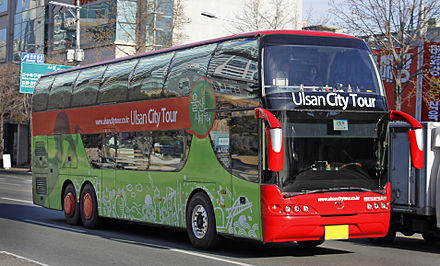 Ulsan has an extensive public bus network with plans in place to build Light Rapid Transit system in the future.
Ulsan has an extensive public bus network with plans in place to build Light Rapid Transit system in the future.
If staying in the city for any length of time then buying the transportation discount card makes economic sense. It will entitle the holder to a ₩50 discount on fares (₩200 discount on Chwaseok "seated" buses) and a free transfer between bus services if made within the hour. Upon exiting the first bus be sure to place the card over the box with an X and O to initiate the free transfer.
The cards can be bought and refilled at the vendor shacks located next to any major bus stop in the city. Depending on design it should cost no more than ₩5,000. This does not include any credit which must be paid for in addition. One great feature is that it can be used on other city transport networks across the country.
By bus
Getting around the city by bus is a lengthy and time-consuming process. The white express bus services alleviate this somewhat but are less frequent on the routes. The regular yellow city buses cost a flat ₩1,150 (₩1,150 by cash, ₩1,100 by prepaid bus card) regardless of your journey's destination. This makes long-distance bus travel economical, but for short trips not so much.
Buses run until about 23:30 in the evening after this they start again early in the morning. Perhaps around 05:00 in some areas. The smaller blue buses only circuit the immediate local area many times a day. These cost ₩600 or more.
Step onto the bus at the front with exact change if possible. Drivers do give change but nothing more than a few hundred won. To exit the bus press one of the red buttons for a stop and step off at the back.
There's also a sightseeing bus service called Ulsan City Tour. Single-decker buses cost ₩5,000, and double-decker buses cost ₩10,000. Reservation is required for all routes. Homepage (English) Same day KTX ticket holders will get 10% discount.
By taxi
Foreigners use taxis in the city frequently and almost always without problem. They're relatively cheap to use especially if the cost is shared among others. Once the bus stops running at night they are the only way to get from place to place over long distances.
The minimum fare begins at ₩2,200 for the first 2 km and increases by ₩100 for every 144 m thereafter. Taking a taxi between midnight and 04:00 will mean an increase of 20% on the minimum fare. ₩2,460 being the new minimum, rising at ₩120 thereafter.
After 04:00 passes the minimum fare immediately returns to ₩2,200. If your driver places it on the higher fare question this action or ask them to stop and get straight out. 04:00 and beyond means ₩2,200.
Be aware if the driver touches the meter at any point during the journey. There is only a need to touch it twice, once when the journey starts and once when it is over – that is unless your journey starts shortly before midnight and continues past in which case they may press a button to start increasing the fare by 20%.
Calling for a taxi should cost an extra ₩1,000 but it is not often noticed on top of the total fare. Speak clearly and slowly to the driver as many have problems understanding a foreigner speaking Korean, no matter how good your skills are.
Should you be involved as a passenger in a taxi in an accident with another vehicle, you may be held responsible for costs incurred - if the driver was not taking you to where you wanted to go - the accident would not have happened. It has happened in the past, and even the police have been called if there is concern that the cost of damages is so high that it could be considered the passenger may not be able to pay immediately!
By train
If you're in some of the outlying areas and live close to a station then it becomes a viable form of transport into the city. For example, Hogye and Hyomun have stations in the north. To the south lie Deokha, Onyang and Seosaeng stations.
Tickets will be cheaper than a taxi but slightly more expensive than the bus. However you'll be into the centre within a few minutes making it well worth that extra couple of hundred won. Check your local station ticket office for arrival and departure times as schedules change depending on season of travel.
By Light Rapid Transit
A Light Rapid Transit (LRT) will be built in the city similar to that found in some European cities. The first of the lines will run through Mugeodong, Munsu Stadium, Gonguptap, Samsandong to Ulsan Station then turning north to Hyomun Station.
Talk
The primary language of Ulsan is Korean. English is not common especially among the older generations and many younger Koreans are shy about using their language skills. They'll often nod and say yes without really having understood a question - which can lead to problems when asking for directions. The Korean phrasebook should provide some useful words and expressions.
See
Twelve Scenic Areas
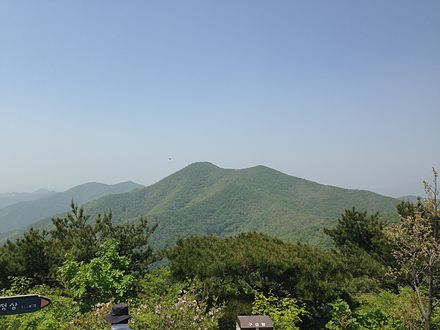
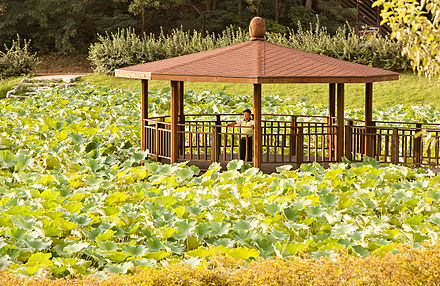
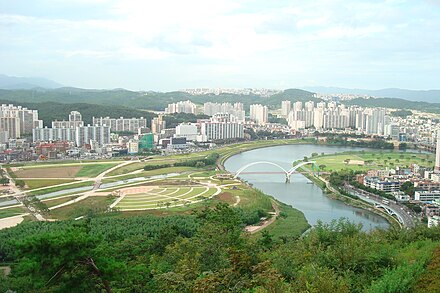 Ulsan has designated Twelve Scenic Areas of interest to tourists visiting the city.
Ulsan has designated Twelve Scenic Areas of interest to tourists visiting the city.
- Four Seasons of Mt Gaji. Selected as one of the 100 Most Beautiful Mountains in Korea, Mt Gaji is the tallest mountain in Ulsan. There are well marked hiking trails up the mountain and are accessible from Seongnamsa Temple.
- Sunrise at Ganjeolgot (간절곶), 35.3597°, 129.36161°. The first sunrise in Northeast Asia can be seen from Ganjeolgot. It is a popular destination for New Year celebrations.
- Black Pebble Beach at Gangdong and Jujeon Seashore. The beach is filled with, well, black pebbles.
- Daewangam Songnim (Pine forest). This coastal area is filled with rock formations, 15,000 pine trees and views of the East Sea.
- Naewonam Valley of Mt Daeun. The tranquil valley is filled with pools of water and waterfalls next to large stones. The Naewonam Temple is also located in the valley amidst the mountain scenery.
- The Night View of the Ulsan Industrial Complex from Mt Muryong. While looking over an industrial complex might not seem like a tourist attraction, the view is something out of Blade Runner or Koyaanisqatsi. Take your tripod to get the best night photos.
- Bangudae. Bangudae refers to the turtle shape of the mountain. This natural area is filled with mountains, valleys and rock formations. It also houses the Bangudae Boulder Petroglyphs from the stone age, a designated national treasure.
- Eoksae (Reed) Plain of Mt Sinbul. Mt Sinbul is the second tallest mountain in Ulsan, with a vast plain covered in reeds. Like Mt Gaji, it is considered to be one of the 100 most beautiful mountains in Korea.
- Ulsan Sports Complex. If you enjoy visiting random stadiums, then by all means, go to the Ulsan Sports Complex, although it seems like it only made the list because Koreans love soccer. Home to one of South Korea's many soccer teams.
- Jakgwaecheon. Formed by many years of water erosion, the river runs straight past a temple. The rocks are engraved with Korean characters and is an excellent place for photography.
- Seonbawi (Standing Rock) and Simnidaebat (Bamboo Grove) of Taehwa River. The combination of rocks, river and the bamboo forest create a breathing space in a highly industrial city. It is linked to the Taehwagang River Grand-Park.
- Paraeso waterfall. A 15-meter-high waterfall with the reflection of the mountain in the pool below.
Museums
- Ulsan Petroglyph Museum, 333-1, Cheonjeon-ri, Dudong-myeon, Ulju-gun.
- Jangsaengpo Whale Museum and Whale Experience Hall, 39-29 Maeam-dong, Nam-gu, Ulsan.
- Oegosan Pottery Village.
Do
Rock climbing
Popular on Munsu Mountain, the tallest in the city. Over 100 sport routes are available from 5.8 up to 5.13
Hiking
Ulsan is the gateway to Gayasan National Park and is accessible from Eonyang, a suburb of Ulsan. Take a bus to the Eonyang terminal and change for a bus heading to Seongnamsa. Hiking in the numerous mountains around the city is very popular, especially among the Koreans. Just about any wooded area will be flush with hiking trails.
The city has a fabulous river park with walking, running and biking trails. Flowers are plentiful and make for pleasant journeys along the river.
Beaches
- Ilsan Beach At the entrance to Daewangam Park, the beach can get incredibly crowded in summer as Koreans flock to the limited space. 977 Ilsan-dong, Dong-gu, Ulsan.
- Jinha Beach Across from Myeongseondo Island, this beach is surrounded by forests of pine trees. 307-2 Jinha-ri, Seosaeng-myeon, Ulju-gun.
Sports
Watch football at Munsu Football Stadium (home to Ulsan Hyundai FC).
Learn
You can take a course at the Oegosan Onggi Village near Ulsan and learn how to make onggi (Korean earthenware).
Work
The most common work available for native English speakers is teaching English as a second or foreign language.
Buy
Eat
Budget
Mid-range
- Pho Bay. Pho Bay is a great Vietnamese restaurant. Try the pho noodle soup. ₩7,000-10,000
- Ulsan Wholesale Fish Market, Samsan-ro, 5-minute walk east from Lotte Hotel, 35.539°, 129.343°. This market is similar to Jagalchi Fish Market in Busan. Customers choose their fish, and the fish is prepared on the spot. Prices are fixed but it can be possible to negotiate some extra fish at no additional cost, though vendors here generally do not speak English. Common dishes include hoe (raw fish, pronounced "hway"), sannakji (dead but still moving octopus), and various fish soups. A small fee is added to the price of the fish for its preparation. Dishes are usually accompanied by vegetables, various sauces, and kimchi. Beer or soju can be purchased for around ₩4000 a bottle. The market also sells whale meat, and it is sometimes possible to see a whale being butchered at the exterior of the building. 2015-02-23
Splurge
The second floor of the Samsandong Skyrex apartment building (the tall twin buildings that can't be missed) hosts a buffet called D'Maris which is focused on seafood, but also hosts a large variety of other dishes and is quite delicious. Cost is ₩36,300 per person.
Drink
- Bench Warmers. Great foreigner bar in Shinae (Old Downtown). They host a poker game on a weekly basis.
Sleep
Budget
Located around the Taehwa River Station, there are numerous motels to choose from. Typically, these motels will cost anywhere from ₩40,000 to ₩60,000 depending on the time of year. Motel prices fluctuate depending on the season and what is going on in the city. If there is a festival on, you could pay more.
Mid-range
- Ulsan Hotel. A business oriented hotel at Gongeoptap Rotary, very close to the Ulsan Grand Park.
Splurge
- Lotte Hotel. The most luxurious place to stay. It is in the center of the main downtown area, just steps away from various bars and shopping. The intercity and express bus terminals are within a few minutes walking distance. One drawback is the lack of food and drink options (two restaurants and no bars in the hotel), however the hotel's location does alleviate this being in the main downtown area with a decent selection of restaurants and bars within 5 minutes walking distance of the hotel.
- Hyundai Hotel. Another 5-star accommodation. It is in Dong-Gu, and unless you are visiting the Dong-Gu area, is very inconveniently located.
Connect
Stay safe
Ulsan, like any city in South Korea, is very safe.
Go next
There are many other cities nearby that are cool to check out for a weekend tour.
- Busan (부산, 釜山) is an hour away by bus from Samsandong. South Korea's second city, there's something for everyone there.
- Gyeongju (경주, 慶州) Ancient capital of the Silla Dynasty a short bus or train ride north. Home of Bulguksa Temple and Seokguram Grotto. It's an open-air museum and not to be missed.
- Daegu (대구, 大邱) Large city with its own unique sights to see.
- Pohang (포항, 浦項) Industrial grit and grim, but a marvelous beach, compact and eminently walkable downtown make this an alternative weekend break.